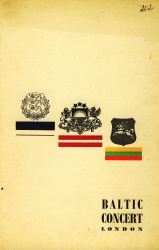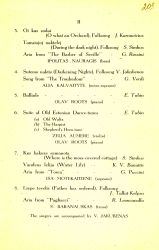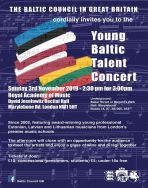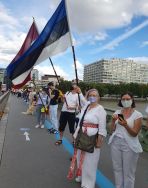After the Second World War, refugees not only from Latvia but also from Estonia and Lithuania arrived in Great Britain. At the beginning of 1947 on the initiative of the envoys of the Baltic states in exile, the Baltic Council was established in London to represent their common interests. The task of the Council was to promote the friendship of the three Baltic nations, to organize joint protests and commemoration services. Architect K. Valdmanis, who was also chairman of the Latvian Society of Great Britain, was elected as the first chairman. The first meeting took place in the hall of Westminster Cathedral on 17 May 1947 and in the autumn, the first concert of Baltic musicians and an exhibition of handicrafts were organized and subsequently, such events took place on a regular basis. The Council also organized joint balls and sports competitions. Friendship evenings were held not only in London, but also in Bradford, Leicester and other cities.
Publicising the plight of the Baltic States under Soviet occupation was a high priority for the Council and it produced numerous leaflets. Resolutions on the occupation and human rights violations in the Baltics were prepared and submitted to the Council of Europe and to members of the British parliament. On 22 April 1956, the Council, along with representatives of other Eastern European nations, organised a demonstration of about 20,000 participants to protest against a visit to Britain by representatives of the USSR government. Among the Council’s activities, of particular note was an annual joint memorial day of services and musical performances for those deported to Siberia by the Soviet authorities and the 25th anniversary of the deportations was commemorated with a concert on 11 June 1966. On 22 September 1968, it held a celebration in the hall of Westminster Cathedral to mark the 50th anniversary of the proclamations of independence of all three Baltic states after WW1. In the late 1980s, in collaboration with the Baltic Association of Great Britain, the Council produced and distributed 10,000 copies of an illustrated coloured brochure about the Baltic states, the demand for which was so great that it had to be reprinted.
In the 1980s, the Baltic Council began organizing special Baltic weekends with the aim of uniting Baltic youth and was actively involved in promoting the Baltic Peace and Freedom Cruise in 1985.
After the Baltic states regained their independence in 1991, it prepared new publicity information, emphasizing the struggle for the withdrawal of Russian troops. In the late 1990s, the Council became actively involved in the campaign for the Baltic States to join the European Union and NATO.
With time, the role of Baltic Council changed, and its slogan became "Representing the Estonian, Latvian and Lithuanian Communities in Great Britain". Now its aim was to enhance the image of the Baltic states by the development of cultural and academic links between the Baltic states and the United Kingdom. On 9 November 2003, the Council hosted the first Young Baltic Talent concert, which has taken place regularly to this day. Since 2004, Baltic Symposia have been organized every two years to discuss current issues in the Baltic States.
The Council also became an organization that represented the interests of the citizens of the Baltic states in Great Britain and after the accession of Latvia, Lithuania and Estonia to the European Union, the Council’s became concerned with the recent arrivals in Britain, the so-called diaspora. These are issues of worker safety, corruption, health care, participation in public life, children's education, mother-tongue schools and teachers' problems.









